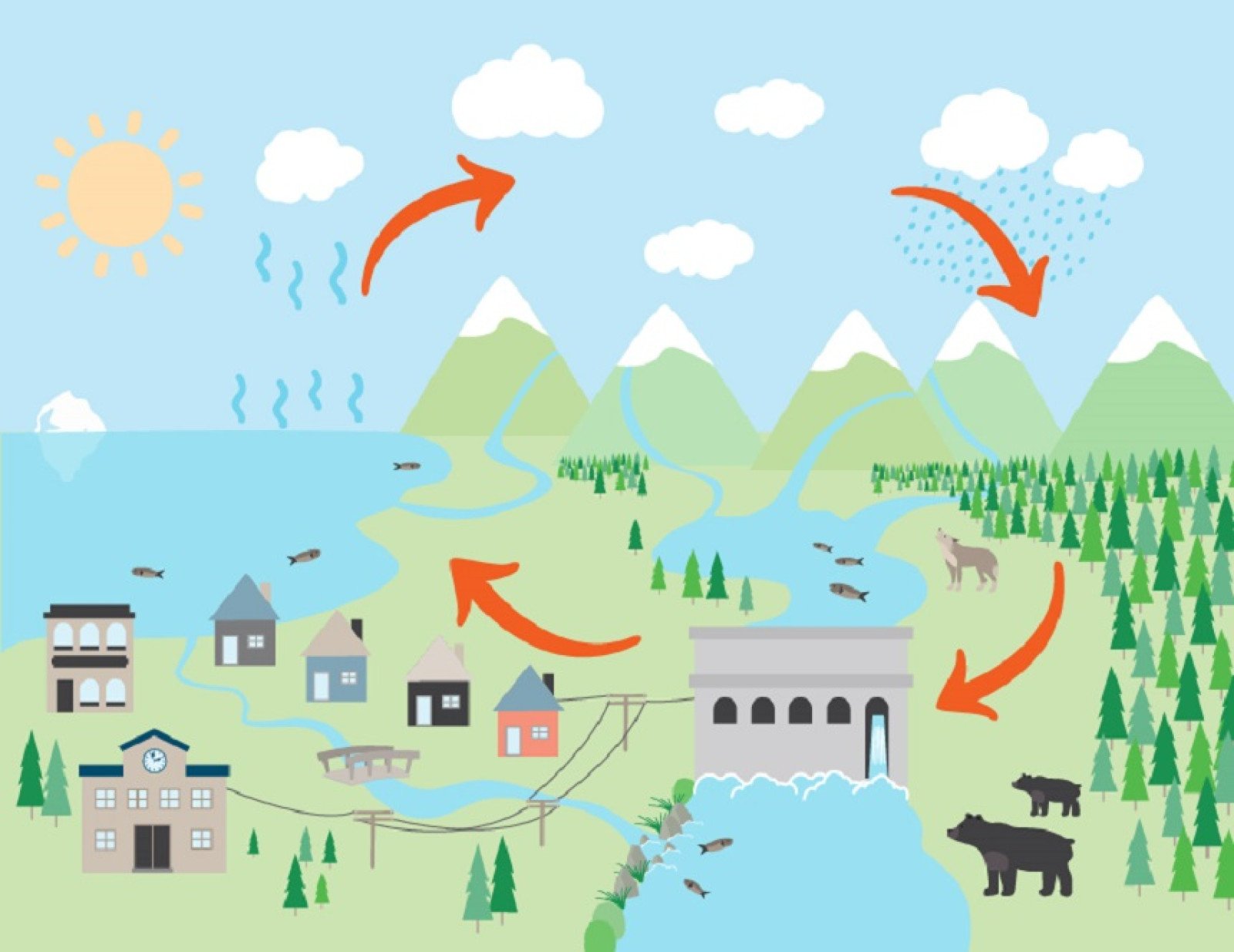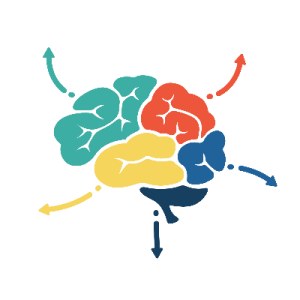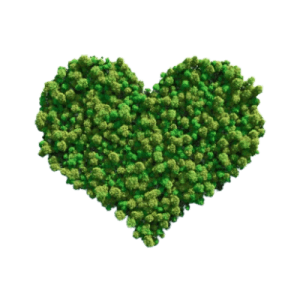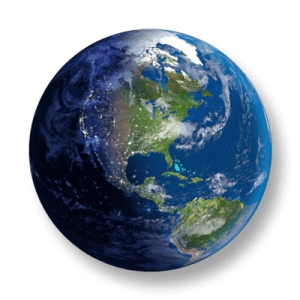Water on the move
Let’s discover how water connects us as water is always on the move -visible and invisible.

Overview
In this activity, students will learn how water connects us, is alive and always on the move. Sometimes water is on the surface in lakes and rivers where we can see it, but sometimes underground, and invisible but always in need of protection.
Instructions
What you'll need
- “Water on the move” video
- Digital projector and screen
- “Water pledge” student handout, one per student
For the water on the move activity
- Roll of paper towel
- 6 cups per group of two to three students (clear reusable cups or compostable paper bathroom cups)
- Red, yellow, and blue food colouring
- Pen/ marker
Groundwater
- Discuss with students that groundwater is invisible and makes up much of the liquid fresh water in the world. In B.C. we have surface water in lakes and rivers, but we also groundwater that many communities access for drinking water.
- Ask students to consider the land we are living on and acknowledge the Indigenous Peoples who have been taking care of the land and waterways for thousands of years. Many Indigenous Peoples have traditions, ceremonies and practices to honour water. Water is like a member of the family; it has a spirit and must be protected.
- Ask students to consider the responsibility we all have today for taking care of the water, protecting it, and being grateful.
- As a class watch this video and ask students to share ways we can protect all water, and in particular groundwater. A good example is not putting chemicals like pesticides and paints on the ground or down the drain.
Water on the move
- Share that water is always moving. Ask students to consider how water moves down like when it rains, or runoff down a hill. Have students share where they have seen water moving downhill. Ask students to consider if water can move up and discuss evaporation when the sun heats up the water from the ground, lakes, and rivers. Water also moves up in plants and trees, through a process of transpiration and capillary action.
- Pull up the “Water on the move” video demonstration to show students.
- The experiment can be done as a class or in small groups. Provide each group with six cups, six small pieces of paper towel and a pen/marker and as a class follow the steps:
- Step 1: Number the cups 1 to 6.
- Step 2: Fill the odd numbered cups (1, 3, 5) ¾ full with water and add 10 drops of food colouring: red in # 1, yellow in # 3 and blue in # 5.
- Step 3: Arrange the cups, in order from 1 to 6, in a circle. Take a piece of paper towel and twist it lengthwise, placing one end in the water and one end in the empty cup next to it. Continue until the cups are all connected by the paper towel. For quickest results tightly twist the paper.
- Step 4: Observe what happens. You will see results quickly but if the experiment can be left overnight, the results will be more dramatic.
4. Have students share what they see. The water will move upwards through the paper towel, and the colours will mix in the empty cups, resulting in a rainbow of colours over time.
5. The water moves up the paper towels through a process called capillary action. The paper towel is made from fibres and the water travels through the gaps in the fibres, which pulls the water upward. In trees transpiration, which is water leaving the tree through its leaves, causes capillary action to take place drawing water up from the roots.
6. Water is always on the move. Maybe it's moving down a hill, going up a tree, or evaporating. It might collect underground (invisible) or on the surface (visible) and will be shared by animals, trees, people and for making clean, green electricity in B.C. We can use water for electricity because it's always on the move.
7. Remember to compost the paper cups and paper towels once the activity is complete.
Ground and surface water
- Remind students that water is always moving. Sometimes water is visible and collects in rivers and lakes. This is called surface water. Sometimes water is invisible, infiltrating through the soil, and collecting in underground aquifers accessible using wells. This is called groundwater.
- Discuss how the same water can move between surface and underground locations; it is not different water, and it is all connected.
- In the classroom, gym or outside, define an area (about the size of the classroom) and designate one side as “surface water” and the other side as “groundwater”.
- Start with students all standing in the middle of the space. Call out a water source and ask students to move to the correct side of the space. Is it groundwater or surface water? Students will return to the middle after each example. Here are some water sources to call out:
- River (surface)
- Pond (surface)
- Aquifer (ground)
- Well water (ground)
- Puddle (surface)
- Lake (surface)
- Bog or wetland (both) It can be groundwater but when the ground is saturated, it can become surface water.
- Ocean (surface) It is surface water but too salty to drink.
- Stream (surface)
- Atmospheric river (neither) An atmospheric river is concentrated moisture in air.
- Conclude the game by sharing that ground and surface water are interconnected and we need to take care of both visible and invisible water. Ask students to consider where water goes when we put it down the drain. Depending on where we live, it could end up in the ocean, lake or river, so taking care of water also includes what we put down the drain.
Wrap up
- Water is essential for all living things, and we need to protect both surface and groundwater.
- Invite students to share specific ways we can protect water, to prepare for making a pledge.
- Provide each student with the “Water pledge” student handout. Students can thoughtfully make a pledge and commit to taking care of water.
- Pledges can be posted in the classroom or corridor or taken home and posted in the home to remind everyone to take care of water.
Modify or extend this activity
- Check out BC Hydro Power Smart for Schools activity “Living in a good way with water” which uses Indigenous teachings and perspectives to help students develop commitments to living in a good way with water.
Curriculum Fit
These activities provide a link to the core competencies of the curriculum. The activities engage students in thinking about the interconnectedness of water and taking action on caring for water.
Core competencies
Communications
- Connect and engage with others (to share and develop ideas)
Thinking
- Creative thinking: generating ideas
- Critical thinking: question and investigate
Social awareness and responsibility
- Contributing to community and caring for the environment
The activities also connect to a variety of grade-specific curricular competencies and content in a variety of subjects including Physical and Health Education, Social Studies and Science.
Assessments
- Assess students’ understanding of how water moves, through gravity, evaporation, and transpiration.
- Assess students’ cooperation and critical thinking doing the “Water on the move” experiment.
- Assess students’ ability to share ideas on protecting water and listening to each other.
Teaching Notes
Groundwater
Often in Canada we only consider surface water sources, as this is clearly visible when we see the many lakes and rivers. However, in Canada, about 30% of the population rely on groundwater for domestic use. Groundwater needs protection as it can be contaminated by landfills, chemical or oil leaks, pesticides, fertilizers, or leaking septic tanks. For more information go to Water sources: groundwater.
Transpiration and capillary action
Plants absorb water and nutrients from the soil as part of a process called transpiration. Water is emitted through the leaves of a plant (transpiration), causing a continuous upward flow or draw of water and nutrients through the roots by capillary action.
BC Hydro’s environmental responsibility
In B.C., we are powered by water. The electrical system stretches across each region of the province and the traditional territories of Indigenous Nations. We have 30 hydroelectric plants and a network of over 80,000 kilometres of power lines that transport electricity from our generating stations over mountain tops, through river valleys to homes and businesses in B.C. We have the cleanest generation in Western North America and amongst the lowest greenhouse gas emissions of any utility in North America.
We recognize that while water is core to our business, it also holds spiritual and cultural values to Indigenous Nations, and environmental importance to all communities in B.C. We’ll work together to protect the province’s water resources and honour these multiple uses and values as we move forward. Check out Environmental responsibility for ways BC Hydro is protecting and sharing the resource.
Young people can take action
Young people can act at school, in their community and at home to protect and care for water. We can empower them with a deeper understanding of how essential water is to life and encourage them to share this message to respect, protect and honour water.








